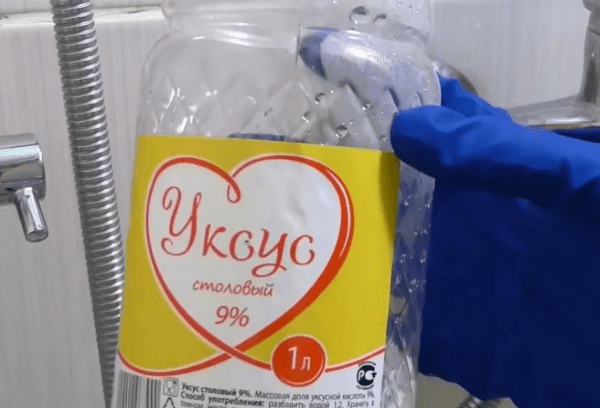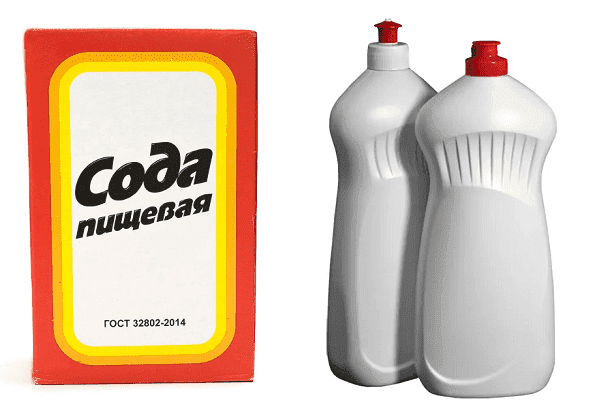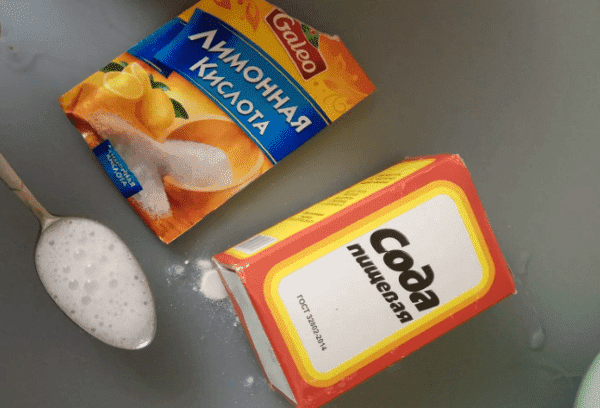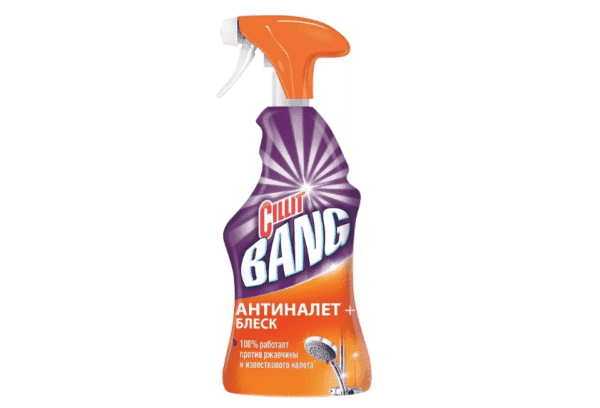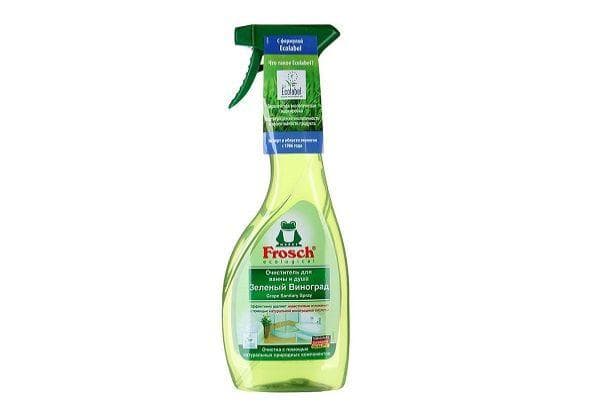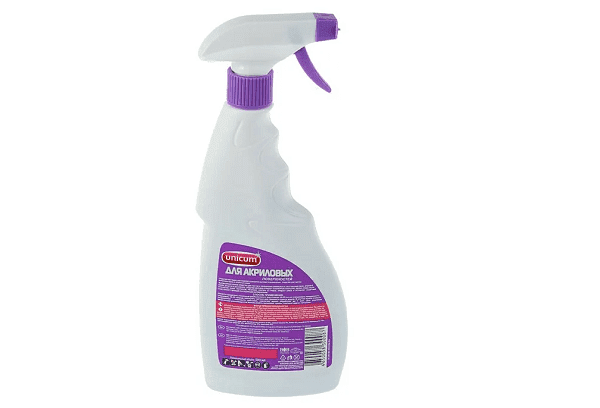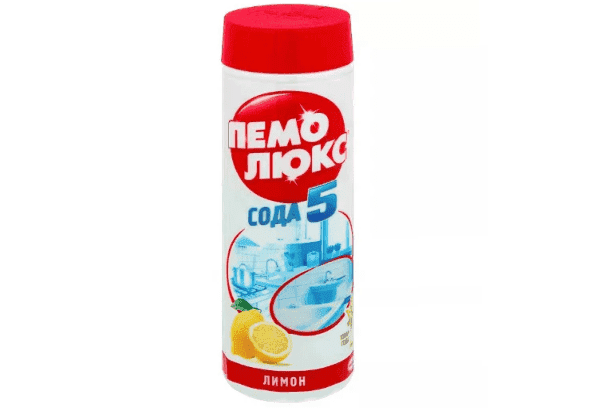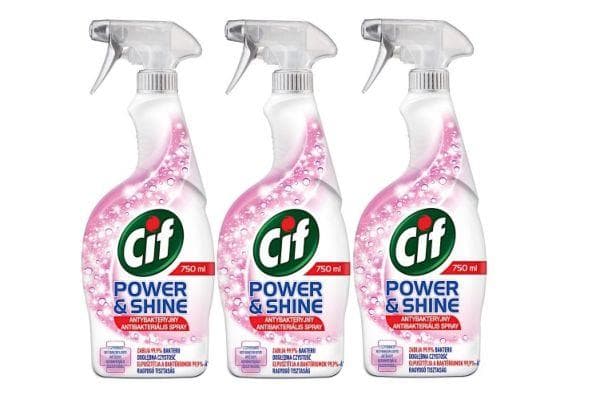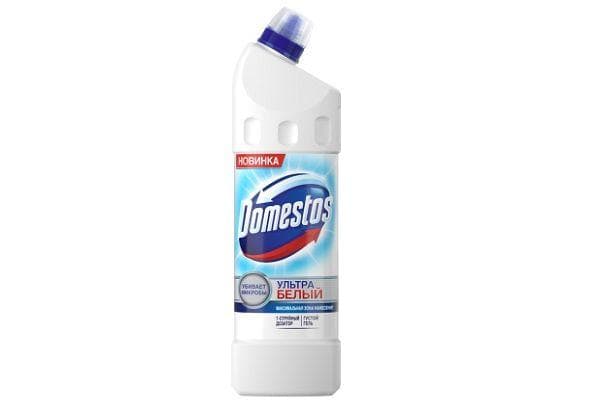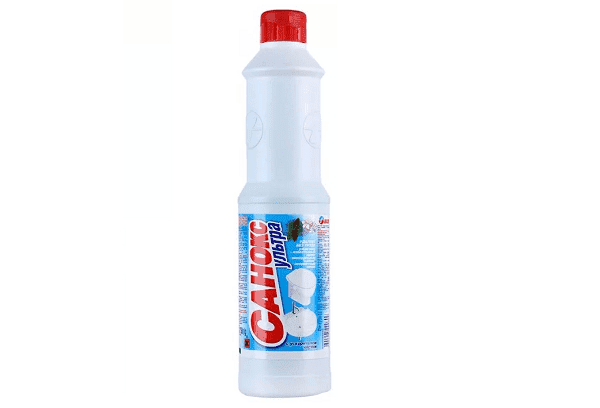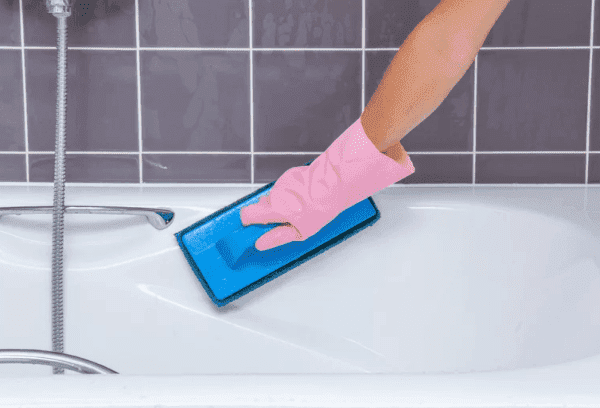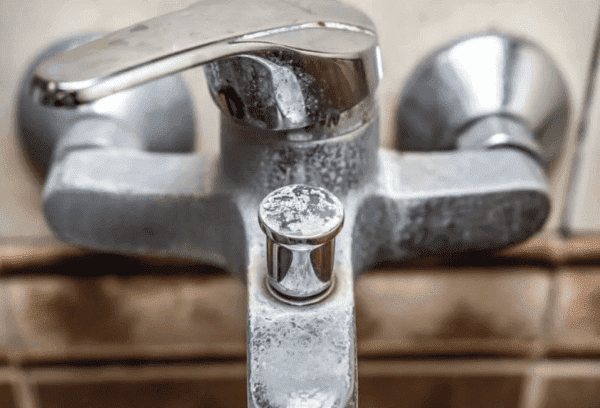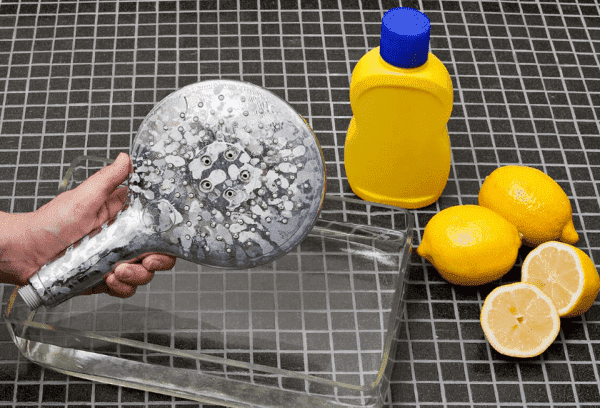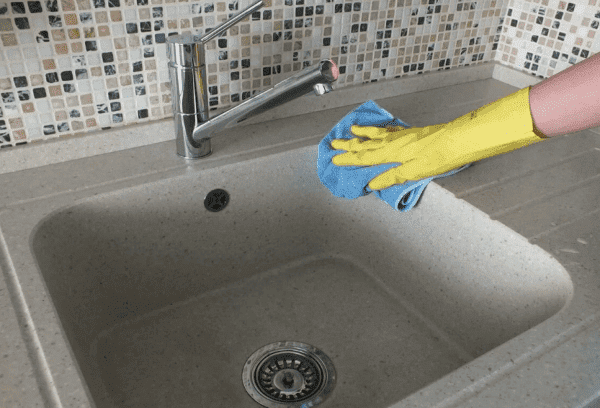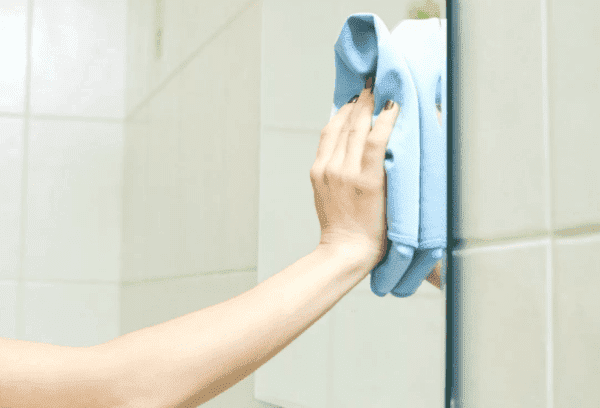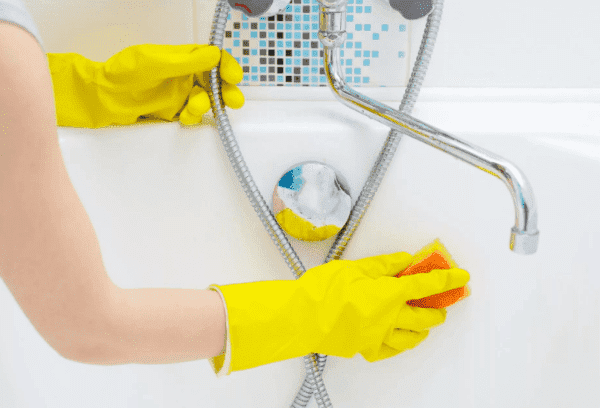11 products + review of how and how to remove limescale in the bathroom
Content:
Limescale is not as bad for the bathroom as mold or rust. It does not spoil health, but greatly worsens the appearance of plumbing fixtures. The saddest thing is that plaque forms quickly, but it is difficult to clean off - stains remain. A proven solution for removing limescale in the bathroom will help reduce cleaning time significantly.
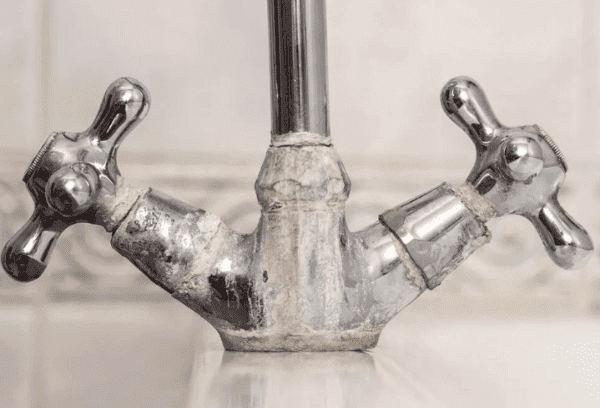
How to remove plaque with home remedies?
Despite the large selection of store-bought remedies for limescale, many housewives continue to use their grandmother’s old methods. Solid deposits are well removed:
- vinegar;
- lemon acid;
- baking soda;
- toothpaste.
Vinegar
Table vinegar 9% is a good old remedy for cleaning the whole house. Using vinegar, they neutralize bad odors in the refrigerator, remove mold in the bathroom, scale in the kettle, and urinary stone in the toilet.It also copes with limescale.
Against plaque in the bathroom, 9% table vinegar is used undiluted.
You can apply it with a cloth or spray it from a spray bottle. After about an hour, the plaque will begin to come off easily and can be brushed off. But the best effect of vinegar can be observed with the following method of application:
- You need to soak a disposable napkin (rag, rag) with undiluted vinegar.
- Apply a compress to the contaminated area for 30 minutes.
- Wipe off the lime with the same cloth. It will become pliable and soft.
- Rinse the surface with warm water.
Naturally, it is better to work with vinegar with gloves and with open doors. Its smell is pungent and can linger in the air for some time after treatment (usually no more than an hour). By the way, some housewives claim that vinegar smells much nicer than household chemicals.
Baking soda and dish detergent
Baking soda is good for cleaning fresh limescale. This is one of the safest means. Pediatricians recommend cleaning bathtubs with baking soda before bathing small children. It disinfects well. Limescale deposits are removed using abrasive particles. To avoid scrubbing the bathtub for a long time, it is recommended to use baking soda in combination with a liquid detergent.
The proportions of soda and detergent are 1:1. To clean the bath you will need about 3-4 tbsp. spoons of soda and the same amount of washing liquid.
It is not necessary to use dish detergent. You can replace it with shower gel, baby shampoo, liquid soap.
Application is simple:
- Combine ingredients in a bowl.
- Spread over the surface of the bath with a sponge.
- Leave for 10-15 minutes.
- Rub with the hard side.
- Rinse off with hot water.
You can see the effect in the video:
After cleaning with baking soda and detergent, your bathtub and shower tray will be sparkling white!
Baking soda and citric acid
Acid is the number 1 enemy of limescale. It is capable of dissolving even old, fossilized deposits. Citric acid works most effectively in combination with baking soda.
How to clean a bathtub from gray and yellow deposits:
- Rinse the walls of the bathtub with hot water.
- Pour 100 g of soda (half a pack) into a small container.
- Add water to make a thick paste (about 100 ml).
- Distribute the soda mixture over the surface and leave until completely dry (15-30 minutes).
- Dilute 3-4 tbsp in a glass of hot water. spoons of citric acid.
- Apply the solution with the hard side of the sponge over the soda. Leave for 15-30 minutes.
- Rinse with clean water.
It is better to carry out cleaning with gloves. When applying the lemon juice solution, a violent reaction will occur. Don't be alarmed. That's how it should be.
Using soda and lemon, the bath is cleaned until it shines:
Sandpaper
To some this method may seem barbaric. It should be used only in extreme cases.
In old enameled bathtubs you can often observe a very hard and thick layer of limescale. It is also called water stone. Sandpaper will help remove such deposits.
- You will need sandpaper with a grit of 100-120.
- Deposits should be cleaned under a small stream of water (shower).
- You won't have to scrub for too long. A couple of minutes and the area will turn snow-white.
If the bath is good, then sandpaper will not wear the enamel down to the cast iron. The coating will not be damaged and will remain white. To achieve greater smoothness, after cleaning with coarse sandpaper, you can go over it with fine sandpaper (400, for example).
Video of the process and result:
How to clean a bathtub with store-bought products
It is logical to assume that all specialized bath cleaning products should effectively remove limescale.
But in reality, not all sprays and liquids cope with the task as well as the manufacturer promises. The most aggressive of them can damage the bathroom coating, while natural ones often simply spread plaque. In order not to be disappointed in your choice, we recommend using products with a good reputation and reviews.
"Cilit Bang Anti-plaque + shine"
The advertised anti-plaque product in the bathroom, according to reviews, does its job well. The spray can easily be used to treat bathtubs, faucets, tiles, and hard-to-reach places. "Cilit Bang Anti-plaque + shine" is suitable for any materials and surfaces. Does not contain chlorine, smells nice.
After application, limescale dissolves within 1-10 minutes. Wipe off the product with a sponge and rinse the plumbing fixtures with clean water. The average cost is 200 rubles per 0.75 liter bottle.
Bath and shower cleaner “Frosch Green grapes”
The spray cannot be called highly effective. It will not cope with hard and rusty deposits.
The advantage of “Frosch Green Grapes” is its safe composition and pleasant smell.
The product contains a small amount of surfactants, organic acids and biodegradable additives. It is recommended for regular bathroom cleaning. The spray widely sprays the liquid, which immediately begins to “eat up” the plaque. After 2-3 minutes, wipe the bathtub with a cloth and rinse with clean warm water. The average price of a bottle of “Frosch Green Grapes” 0.5 l is 250 rubles.
Spray "Unicum for acrylic surfaces"
Forms foam when sprayed. It dissolves lime and soap deposits on acrylic bathtubs and plastic parts in a matter of minutes.The surface is wiped with a cloth and rinsed. According to reviews, the product is good for regular cleaning, but does not cope with hard deposits. Has a pungent odor. Handling with gloves and a mask is recommended.
The approximate price of “Unicum for acrylic surfaces” is 220 rubles (for 0.5 l).
Cleaning powder “Pemolux Soda 5 extra”
A cheap and effective remedy against limescale in the bathroom. The powder consists of soda, surfactants and oxygen bleach. Cleans the bathtub to a shine. You need to sprinkle Pemolux on a damp surface, rub and rinse off after 5-10 minutes. Suitable for ceramic, metal and enamel surfaces.
Average cost – 60 rubles. for 480 g of powder.
"Cif Power & Shine"
A cleaning spray from a well-known manufacturer easily removes limescale.
Cif Power & Shine is suitable for all surfaces except natural stone, marble and painted wood. Has a dirt-repellent effect.
Has a fresh, pleasant smell. Processing can be carried out without gloves. To remove limescale deposits in the bathroom, spray the spray onto the dirt and wash it off after a few seconds. It works immediately. If the deposits are old and hard, you need to wait 10 minutes.
Approximate cost – 360 rubles. for 0.75 l.
"Domestos Ultra White"
A well-known toilet cleaner. Helps remove even the hardest limestone, rust and other contaminants. They often use it to clean enamel bathtubs. The manufacturer indicates that the gel is suitable for cleaning baths, showers, tiles and tiles, floors, sinks, plumbing fixtures, and pipes.
The treatment is carried out wearing gloves and a mask with good ventilation. The transparent gel smells strongly of bleach. It is applied to the stain for 5-15 minutes and then washed off. The average cost is 170 rubles per 1 liter.
Attention! Preparations containing bleach (sodium hypochlorite), sulfuric, hydrochloric, nitric acid should be used only in case of severe contamination of the bath, as a one-time impact method. After cleaning, the bathtub should be thoroughly rinsed with clean water.
"Sanox Ultra"
A cheap and very effective cleaner for toilets and bathtubs. "Sanox Ultra" does not contain bleach, but it still has a pungent, chemical smell. Processing should be carried out with gloves. Due to its gel-like consistency, the product is convenient for washing bathtubs, wall tiles, and plumbing fixtures.
The plaque dissolves before our eyes. In severe cases, you can leave it on the surface for 5-10 minutes. Active ingredients: surfactants, oxalic acid, sulfamic acid. The average cost is 60 rubles per 0.75 liter bottle.
Features of materials
Modern bathtubs are made from different materials: cast iron, steel, acrylic, enamel. Accordingly, they need a different approach.
If you are going to use something completely new to clean limescale, test the product first in an inconspicuous area.
Each material has its own characteristics:
- Acrylic bathtub is sensitive to hard abrasives, brushes, and caustic substances. It scratches easily and may lose its gloss. For cleaning, special liquid and gel products, soft brushes, and wipes are recommended. The exposure time cannot be increased. The jar must be marked “suitable for acrylic bathtubs.”
- An enamel bathtub is easier to clean from limescale. You can use various cleaning powders, store-bought products with acids, surfactants, sodium hypochlorite, brushes and hard sponges. Metal scrapers and caustic alkalis and acids not intended for cleaning plumbing equipment are prohibited.
- A cast-iron bathtub retains heat well, does not deform, and absorbs the noise of rising water. Usually the enamel on it is strong and thick. It's difficult to damage it.
- A steel bathtub is considered the strongest. But at the same time, the market is full of low-quality steel bathtubs - thin, with poor coating. It is better to clean a cheap steel bathtub from limescale in the same way as an acrylic one.
Problem areas
It's not just the bathtub and shower stall that get limescale deposits. It can be found in all corners of the bathroom. Especially a lot of deposits accumulate:
- on the shower head;
- on the mixer;
- at the bottom of the tiles on the wall;
- on the floor under the bathtub and sink;
- on the mirror and glass of the shower stall.
It’s good if the limescale remover is universal and suitable for all types of surfaces. It's easier and simpler to clean your entire bathroom in one fell swoop.
If there is no such remedy, various tricks come to the rescue.
On tap
Chrome-plated taps, if left unused, can be easily cleaned of deposits with a napkin. But not ordinary, but microfiber. Rigid loops on one side remove deposits. The napkin absorbs them, and the surface of the tap becomes shiny again.
What does it look like to remove plaque from a faucet with a napkin without detergents:
Please note that there are different types of microfiber cloths. To remove limescale, you need those designed “for cleaning the bathroom.” Housewives praise the Chistyulya company. Napkins are sold as a set and cost 120-140 rubles per pair. They cope well not only with lime deposits, but also with fat and carbon deposits. After use, the cloth is washed and used again for its intended purpose.
Advice. If a microfiber cloth does not remove plaque well, you need to slightly moisten it.
Shower on the watering can
The shower head suffers the most from limescale deposits. It accumulates not only outside, but also inside. If it is not removed, the ducts become clogged and water begins to flow in a thin stream.
To restore the flow and clean the surface of the watering can from plaque, the following life hack is often used at home:
- You need to take a thick plastic bag without holes.
- Pour 25-30 g of citric acid inside.
- Secure the bag with lemon on the shower head with rubber bands for money.
- Turn on hot water for 2-3 seconds. It is necessary that the water gets into the bag and the resulting solution covers the entire watering can. But it is important that the bag does not hang down from the gravity of the water.
- Leave the shower head to soak overnight (8 hours).
- In the morning, carefully remove the bag. Do not pour out the contents. You can also clean something else with lemon juice solution. For example, a kettle from scale or a toilet cistern from scale.
- Turn on hot water for 2-3 minutes. All the limestone will come out, the pressure will be restored, and the surface of the watering can will shine with cleanliness.
How to clean limescale from a shower head without unscrewing anything:
On tiles
Purchased products work well with small deposits on tiles. But if there are a lot of lime deposits, white stains may remain on the tiles. For complete cleansing, repeated cleaning is recommended (sometimes 2-3).
You can go another way. To remove a thick layer of lime in one moment, you need to treat the tiles with a concentrated solution of lemongrass. If you do everything according to the recipe, the tile will become perfectly clean and there will be no streaks left.
How to remove limescale on bathroom tiles:
- Pour 100 g of citric acid into a small container.
- Add 5 tbsp. spoons of hot water.
- Mix well (for 5 minutes).
- Spread over the tiles with a sponge.
- Leave for 1 hour.
- Rub with the rough side of the sponge.
- Rinse off with warm water.
In this way, you can wash even the dirtiest tiles under the bathtub and sink. The method works 100%.
On the sink
A classic ceramic sink is easy to clean from plaque. You can use any of the remedies listed here.
How to quickly clean a bathroom sink from plaque:
- In order not to waste a lot of time, some housewives wash the washbasin from plaque with toothpaste. Squeeze a small pea onto a sponge and rub the surface. After 5 minutes, go over with a brush or washcloth. You can also clean the faucet with toothpaste.
- The sink can be cleaned in minutes with washing powder. You need to pour hot water over it, scatter a small handful of powder, and rub with a sponge. If the plaque is old, you need to wait 5-10 minutes. But usually you don't have to wait. All deposits are immediately cleaned off, and the sink becomes snow-white. All that remains is to wash off the powder with hot water.
- A very dirty sink can be washed off limescale with “Belizna” or “Domestos” (but only ceramic!). The product is applied with gloves and left for 5-15 minutes. Then they are brushed and rinsed with warm water.
On glass and mirror
Limescale deposits in drops on glass surfaces. If the stains are fresh, you can clean the surfaces with any window cleaner. You need to spray the spray onto dry glass (mirror) and rub with a dry microfiber cloth.
Old stains are more difficult to deal with. They may smear. To remove such plaque, you need to use a special plaque remover - spray and leave on the surface for 10-15 minutes.
Or prepare an effective home remedy using citric acid and Fairy. Recipe:
- Pour 300 ml of hot water into a spray bottle.
- Add 25 g of citric acid and 3 teaspoons of Fairy.
- Shake. The solution should be homogeneous, without grains.
- Spray glass and mirrors well and leave for 40-60 minutes.
- Rinse off with hot water (you can shower).
- Wipe the surface with a dry cloth.
Prevention
You won’t be able to forget about limescale in your bathroom forever, but you can reduce its formation to a minimum. There are a number of preventive measures that can be taken:
- Wipe the bathtub dry after use. Get microfiber cloths. They absorb moisture well and clean surfaces without chemicals. You need to wipe everything with a napkin: faucets, mirrors, shower glass, bathtub (tray), tiles.
- Clean limescale while it is soft. If plaque is not removed in time, it will turn into scale. The scale, in turn, is converted into limestone. This problem is much more serious and may require drastic measures.
- Install a water softener filter in the tap. There are different designs: mechanical, carbon, electromagnetic, ion exchange and reverse osmosis. They cost a lot, but they work effectively. If plaque appears on plumbing fixtures, it is very soft and easily removed. The filter also helps prevent the formation of scale in a washing machine, boiler, and kettle. Soft water is also good for skin and hair.
- Use products that form a water-repellent film on surfaces. Many window cleaning sprays have these properties. They can be sprayed on bathroom tiles, mirrors and glass. Drops of moisture will drain without stopping. As a result, surfaces will remain clean longer.
Questions and answers
Where does limescale come from in the bathroom?
From hard water, dirt, detergent particles. Hard water contains insoluble salts (sulfates, chlorides), magnesium, calcium. Remaining on surfaces, moisture evaporates, and the sediment mixes with contaminants. A durable gray coating forms. Sometimes it resembles rust (if there is a lot of iron oxide in the water).
How often should limescale be cleaned?
Every 1-3 weeks. If preventative measures are taken, the bathtub can remain clean for up to a month.
A clean home is a cozy home. But at what cost does keeping your bathroom clean? Limescale forms wherever water enters. In order not to spend a lot of effort on cleaning the bathtub, you need to use effective products and carry out prevention.
